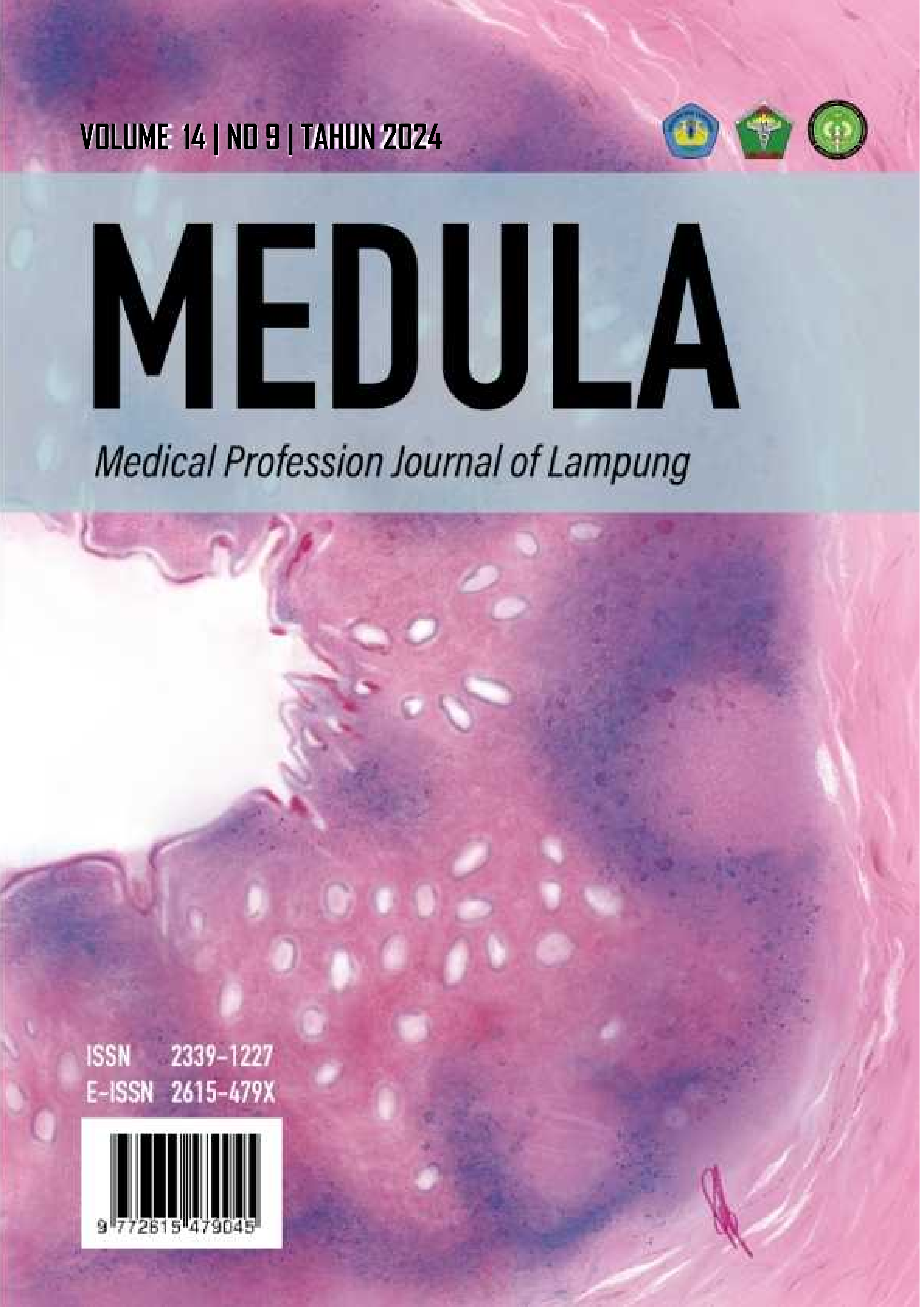Severe Preeclampsia and HIV Infection in a Primigravida at 37 Weeks of Pregnancy: A Case Report
DOI:
https://doi.org/10.53089/medula.v14i9.1197Keywords:
HIV, preeclampsia, sectio caesareaAbstract
The three main causes of maternal death in obstetric fields are: bleeding, hypertension in pregnancy, and infection. Severe preeclampsia is hypertension that appears at 20 weeks of pregnancy with accompanying organ disorders. HIV infection during pregnancy can cause vertical transmission from mother to child both during pregnancy and during labor. This case report discusses a primigravida woman in 37 weeks' gestation, with the chief complaints of about to give birth with HIV positive, there is no history of hypertension before pregnancy. Patient's physical examination showed fully conscious, blood pressure 161/112 mmHg, pulse frequency 112 x/minute, breathing frequency 20 x/minute, temperature 36.5ºC. Generalized status is obtained within normal limits. On obstetric examination, TFU is 39 cm, the uterus contracts with a frequency of 3 times in 10 minutes and a duration of 30 seconds, fetal heart rate 131 x/minute and 135 x/minute. Ultrasound examination is obtained by a double fetus. Patients undergo blood tests and obtained hemoglobin value 11.7 gr/dl, leukocytes 6,800/μl, hematocrit 33%, platelets 285,000/μl, AST 18 U/L, ALT 7 U/L, Ureum 18 mg/dl, creatinine 0 , 68 mg/DL and LDH 326 U/L. On urinalysis 150 protein (++). On immunological and serological examinations, HIV positive results were obtained. Management for this patient is observation of vital signs, uterine contractions, fetal heart rate, 1-3 hours stabilization, catheter installation permits with input/output recording. Medications were given to the patient including RL 20 drops/minute, 4 grams MgSO4 40% then drip 6 gram MgSO4 40% in RL 500 cc 10 drops/minutes, nifedipine orally 3x10mg, and injection of dexamethasone 10mg/12 hours, ARV medicine and performed termination of pregnancy by caesaria section. Childbirth through caesaria section surgery is at a less risk for transmission to infants, but adds other risks to the mother. Good, intraoperative, and postoperative preoperative management will make this caesaria section successful without obstacles.
References
Perkumpulan Obstetri dan Ginekologi Indonesia, Himpunan Kedokteran Feto Maternal. Pedoman Nasional Pelayanan Kedokteran: Diagnosis dan Tatalaksana Pre-eklamsia. Jakarta: POGI; 2016.
Uzan J, Carbonnel M, Piconne O, Asmar R, Ayoubi JM. Pre-eclampsia: pathophysiology, diagnosis, and management. Vasc Health Risk Manag. 2011;7:467–74.
Say L, Chou D, Gemmill A, Tuncalp O, Moller AB, Daniels J, et al. Global causes of maternal death: a WHO systematic analysis. Lancet Glob Health [Internet]. 2014 [cited 2015 Feb 05];2(6):e323–33. Available from: http://www.acog.org/-/media/Committee-Opinions/Committee-on-Obstetric-Practice/co623.pdf?dmc=1.
Royal College of Obstetricians and Gynaecologists (RCOG). Hypertension in pregnancy: diagnosis and management. NICE Guideline 133. 2023.
Hartanto M. Infeksi Human Immunodeficiency Virus (HIV) dalam Kehamilan. CDK. 2019;46(5):1–5.
Kementerian Kesehatan Republik Indonesia. Pedoman Nasional Pelayanan Kedokteran Tata Laksana HIV. Keputusan Menteri Kesehatan Republik Indonesia Nomor HK.01.07/MENKES/90/2019. Jakarta: Kemenkes RI; 2019.
Kementerian Kesehatan Republik Indonesia. Pedoman pelaksanaan pencegahan penularan HIV dan sifilis dari ibu ke anak bagi tenaga kesehatan. Jakarta: Kemenkes RI; 2015.
Ruiter A, Taylor GP, Clayden P, Dhar J, Gandhi K. British HIV Association guidelines for the management of HIV infection in pregnant women. HIV Med. 2014;15(Suppl 4):1–77.
Cunningham FG, Leveno KJ, Bloom SL, Spong CY, Dashe JS, Hoffman BL, et al. Sexually Transmitted Infections. In: Williams Obstetrics. 25th ed. New York: McGraw-Hill Education; 2018. p. 1247–50.
Duley L, Meher S, Jones L. Drugs for treatment of very high blood pressure during pregnancy. Cochrane Database Syst Rev. 2013;(7):CD001449.
Kourtis AP, Bulterys M. Mother-to-Child Transmission of HIV: pathogenesis, mechanisms and pathways. Clin Perinatol. 2010;37(4):721–37.
World Health Organization. Technical Brief: Preventing HIV during pregnancy and breastfeeding in the context of PrEP. Geneva: WHO; 2017 [cited 2025 Feb 17]. Available from: http://apps.who.int/iris/bitstream/handle/10665/255866/WHO-HIV-2017.09-eng.pdf?sequence=1.
Abrams EJ, Anderson J, Brookie M, Chakraborty R, Cohn SE. Recommendations for the use of antiretroviral drugs in pregnant women with HIV infection and interventions to reduce perinatal HIV transmission in the United States. USA: U.S. Department of Health and Human Services; 2018. Available from: https://aidsinfo.nih.gov/guidelines.
World Health Organization. Breast is always best, even for HIV-positive mothers. Bull World Health Organ. 2010;88(1):1–80.
Dekker A, Sibai BM. Etiology and pathogenesis of preeclampsia: current concepts. Am J Obstet Gynecol. 1998;179(5):1359–75.
Downloads
Published
How to Cite
Issue
Section
License
Copyright (c) 2025 Medical Profession Journal of Lampung

This work is licensed under a Creative Commons Attribution-ShareAlike 4.0 International License.














